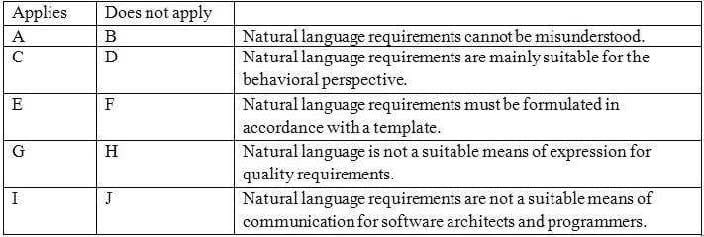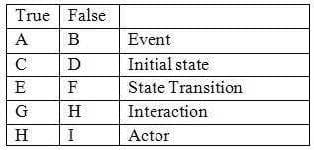Exam Details
Exam Code
:CPRE-FLExam Name
:IREB Certified Professional for Requirements Engineering - Foundation Level (CPRE FL)Certification
:IREB Certified Professional for Requirements Engineering (CPRE)Vendor
:ISQITotal Questions
:45 Q&AsLast Updated
:Apr 26, 2024
ISQI IREB Certified Professional for Requirements Engineering (CPRE) CPRE-FL Questions & Answers
-
Question 1:
Within system development, conflicts continually arise between stakeholders with regard to the requirements. As a requirements engineer, how do you handle conflicts in projects best? (1 Point)
A. You resolve the conflict with the best resolution technique available to you.
B. You analyze the conflict, try to bring about a solution with a suitable technique and document relevant information about the conflict.
C. You ignore the conflict since this is a matter for project management.
D. In order to resolve such conflicts you escalate them via the escalation paths defined in the project.
-
Question 2:
Assess the following statements about the natural language documentation of requirements in terms of being applicable or not applicable. (2 Points)

A. B, D, F, H, J
-
Question 3:
As input for the system development, the Board of Directors of an automotive manufacturer has specified the following goals:
1.
The infotainment system should be easy to operate.
2.
The user must be able to operate the system without becoming distracted from the road traffic.
3.
The system should function without an additional power source.
4.
The system should be configurable for various models of car.
With which two approaches can these goals be detailed and refined best? (2 Points)
A. Clear specification of the goals with the help of use casesand the associated activity diagrams.
B. Documentation of the goals in a sequence diagram.
C. Decomposition of the goals with the help of goaltrees, in order to obtain more concrete goals.
D. Formulation of other goals, since the given goals are not feasible.
-
Question 4:
The following state diagram is to be found in a requirements specification for an order management system. Which of the following requirements is consistent with the diagram and which are not? (2 Points)

A. A, D, F, G
-
Question 5:
Which of the following elements are elements of a state diagram and which are not? Please indicate true or false. (1 Point)

A. A, C, E, H, I
-
Question 6:
Requirements must be checked in terms of content, documentation and agreement. Indicate with regard to this whether each statement is true or false. (2 Points)

A. B, D, F, H
-
Question 7:
In a meeting held with the goal of validating a set of requirements, two participants become involved in an in-depth discussion about the content of a requirement. One of the participants is of the opinion that the requirement must be realized as described, since the success of the product is otherwise jeopardized. The other party dissents and argues that this requirement cannot be realized technically as described. What is the best way for you to react to this situation? (1 Point)
A. You note both arguments and let the project manager make the decision.
B. You invite all stakeholders to a workshop and try to reach agreement.
C. You prefer the second opinion since you believe that the discussion makes no sense if the requirement cannot berealized.
D. You get together with the affected stakeholders and attempt to reach an agreement on this.
-
Question 8:
You model invoices and invoice items with a UML class diagram. The total amount of an invoice is calculated by summing up all individual invoice items. This means that an invoice showing 5 article prices contains 5 invoice items. What model element most accurately describes the relationship between invoice and invoice items? (1 Point)
A. Composition
B. Aggregation
C. Generalisation
D. Association
-
Question 9:
You carry out modelling of requirements with a use case diagram. Which answer best describes its prospective modelling elements? (1 Point)
A. Objects, activities and associations
B. Actors, messages and activities
C. Objects, use cases and activities
D. Actors, use cases and associations
-
Question 10:
The activity diagram below shows a simplified order processing procedure. Which of the following statements is correct for this flow? (2 Points)
A. The flow is not modelled correctly, since no condition (branch)should be present within a fork.
B. The flow is modelled correctly: the goods branch as well as the export and domestic order branch are processed in parallel to one another.
C. The flow is not modelled correctly, since the branches for the domestic and export orders must be consolidated via a diamond symbol.
D. The flow is modelled correctly and the "issue invoice" activity is conducted after the "compile goods" activity.
Related Exams:
CPRE-ALRM
IREB Certified Professional for Requirements Engineering - Advanced Level Requirements ManagementCPRE-ALREC
IREB Certified Professional for Requirements Engineering - Advanced Level Requirements Elicitation and ConsolidationCPRE-AA
IREB Certified Professional for Requirements Engineering - RE Agile AdvancedCPRE-AP
IREB Certified Professional for Requirements Engineering - RE Agile PrimerCPRE-FL
IREB Certified Professional for Requirements Engineering - Foundation Level (CPRE FL)
Tips on How to Prepare for the Exams
Nowadays, the certification exams become more and more important and required by more and more enterprises when applying for a job. But how to prepare for the exam effectively? How to prepare for the exam in a short time with less efforts? How to get a ideal result and how to find the most reliable resources? Here on Vcedump.com, you will find all the answers. Vcedump.com provide not only ISQI exam questions, answers and explanations but also complete assistance on your exam preparation and certification application. If you are confused on your CPRE-FL exam preparations and ISQI certification application, do not hesitate to visit our Vcedump.com to find your solutions here.